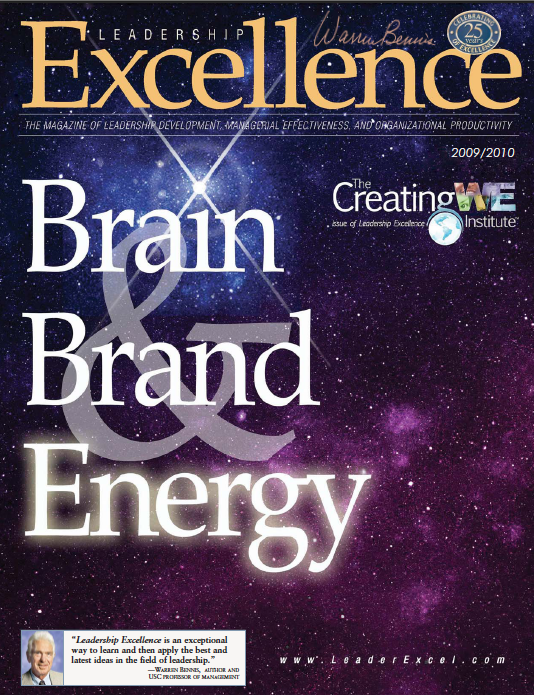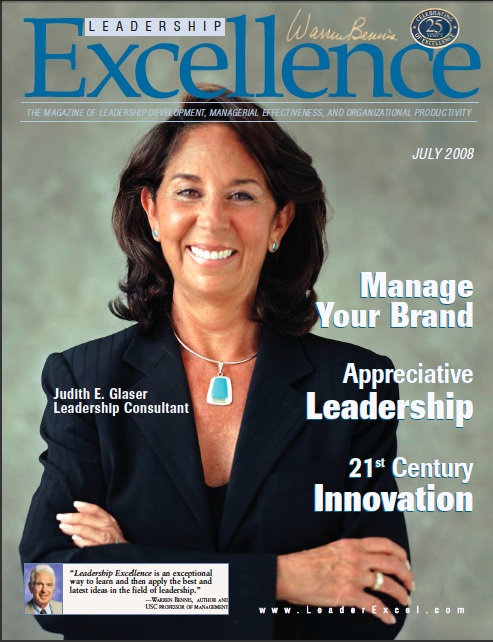By Rex Jung, Judith E. Glaser and Jerry Manas | Leadership Excellence
Published August 2008
Put 'brain' back into brainstorming.
The more we learn about how the brain grows, adapts, changes and—on the other extreme—falls into patterns of thinking, the more we see that a leader’s job is creating environments for innovation. Enhancing interaction during brainstorming enables us to tap into our hardwired DNA and leverage the enormous capacity and deft flexibility of our brains to enhance innovation.
Suppose you’re invited to participate in a brainstorming session. The facilitator says that “every idea counts” and invites you to propose many ideas in the next 10 to 15 minutes. You feel rushed, and notice a push to come to consensus. The effort of organizing and narrowing the ideas then begins. Ideas are posted and you dutifully put dots on those you think are best. Next, you step back, see where the dots are densely clustered, and choose 10 good ideas. The facilitator posts them, announces the top three, does a bake-off of these three, and declares the winning idea.
 Of course, everyone is not on board with the chosen idea. Some people are willing to abandon their pet ideas; others go underground and create resistance. Some give up and give in.
Of course, everyone is not on board with the chosen idea. Some people are willing to abandon their pet ideas; others go underground and create resistance. Some give up and give in.
This process is “innovation by committee.” Mediocre ideas emerge, driven by the need to converge, reach consensus, and avoid conflict. This is a far cry from what we can achieve in innovation. We need to nurture the ideation process and allow room for divergence.
Divergent Thinking
People want to be connected and be part of a winning team. This need is a powerful drive. Our brains accommodate the complex interplay between individuals, groups, and societies. Similarly, we want to feel successful and competent. We strive to find our comfort zone where we can project a positive image, be smart, and feel included. Sadly, these tendencies also inhibit innovation.
Thinking the same thoughts repeatedly lulls us into a sense of comfort. We think we know the “correct” answer, which reinforces feelings of intelligence and good judgment. We may not even realize we are in a repetitive loop, or experiencing status quo thinking. Instead, we feel good that we got it right.
Thinking repetitive thoughts etches “grooves” into the brain. MRIs show that the gray matter nodes, regions of the brain that do the processing, are well developed. So is the white matter that connects those nodes. The brain is reshaping itself and reinforcing what it knows, perhaps at the expense of what is new and novel. Along these well-trodden paths, brain structure serves to link learning to behavior in predictable ways.
Innovation likely resides in regions of the brain both overlapping and distinct from these well-developed pathways. Divergence, one aspect of new and innovative thinking, requires that we expand our ideas into the far recesses of our brain that may be less comfortable or familiar. Yet getting into those parts of the brain forges new connections— both at the idea level and at the level of the brain tissue itself.
We raise our Innovation IQ by making new brain connections daily. Facilitating divergence fosters fresh thinking.
Debunking Creativity Myths
Wise leaders raise Innovation IQ by challenging three common myths.
Myth 1: Creativity is a right brain activity—some have it, some don’t. If we are inclined to be logical thinkers, drawing upon the left side of our brain, then we are probably not creative. Truth 1: Creativity is a skill set that uses the whole brain. Creativity is a whole-brain activity, distributed between left and right hemispheres. While the left-brain’s function is described as “logical” and the right brain as more “innovative,” that does not make the left logical and the right creative. Action steps: Notice your first inclination and let it pass—that is where your groove exists. Spend time with your second, third, or fourth inclination. Let go of the need to judge your ideas immediately. Let them flow first.
Myth 2: There is no creativity without an “aha moment.” To be creative, you need to wait for that magic “aha moment”—that without this flash of insight, creativity cannot happen. So we wait for that perfectly formed idea to spring into our mind, often afraid to share other ideas that are taking shape. We even suppress them, telling ourselves they are stupid. But allowing many divergent ideas to emerge primes our brain to make new connections. Truth 2: Rather than wait for a sudden insight or a perfect and safe solution, generate a wealth of ideas. Many innovative ideas come through experimentation and discovery— the best way to have a good idea is to have many ideas. We need to prime our brains to freely generate and express ideas, not suppress them. Action steps: State the problem or challenge. Find trigger words related to your challenge to get your juices flowing. Sleep on it, watch a movie, go to a park. Prime the pump by getting off task and allowing the idea to percolate. Get moving—motion stimulates creativity.
Myth 3: Innovation should either be a loose, freefor- all activity, or a consensus exercise. We tend to think that there is one right idea or one best way to solve a problem. But if we spend most of our time free-associating, we may not arrive at a pragmatic solution. If we devote all our efforts to driving consensus, we won’t engage in the divergence, abstraction, and wandering thought processes to get to the most innovative ideas. Truth 3: To innovate, you need to give equal attention to divergence and convergence. Mastery of the interplay between these two makes for a great innovator, tapping into both the intelligence and creative capacity of what is known and what is possible. Action steps: Remove the fear of making mistakes or feeling stupid by incorporating “safe” feedback. Advocacy is part of the innovation. Great ideas are worth fighting for, and such ideas need a champion.
These myths undermine our ability to innovate. We need to use the whole brain, prime our brains to generate unsuppressed ideas, and give equal attention to divergence and convergence to boost our Innovation IQ.




